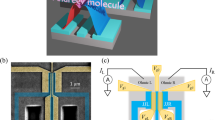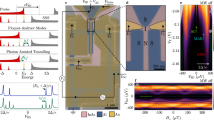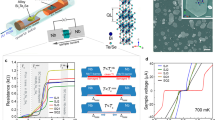Abstract
Multi-terminal superconducting Josephson junctions based on the proximity effect offer the opportunity to tailor non-trivial quantum states in nanoscale weak links. These structures can realize exotic topologies in several dimensions1, for example, artificial topological superconductors that are able to support Majorana bound states2,3, and pave the way to emerging quantum technologies4,5,6,7 and future quantum information schemes8. Here we report the realization of a three-terminal Josephson interferometer based on a proximized nanosized weak link. Our tunnelling spectroscopy measurements reveal transitions between gapped (that is, insulating) and gapless (conducting) states that are controlled by the phase configuration of the three superconducting leads connected to the junction. We demonstrate the topological nature of these transitions: a gapless state necessarily occurs between two gapped states of different topological indices, in much the same way that the interface between two insulators of different topologies is necessarily conducting9. The topological numbers that characterize such gapped states are given by superconducting phase windings over the two loops that form the Josephson interferometer. As these gapped states cannot be transformed to one another continuously without passing through a gapless condition, they are topologically protected. The same behaviour is found for all of the points of the weak link, confirming that this topology is a non-local property. Our observation of the gapless state is pivotal for enabling phase engineering of different and more sophisticated artificial topological materials1,4,5,6,7.
This is a preview of subscription content, access via your institution
Access options
Subscribe to this journal
Receive 12 print issues and online access
$259.00 per year
only $21.58 per issue
Buy this article
- Purchase on Springer Link
- Instant access to full article PDF
Prices may be subject to local taxes which are calculated during checkout




Similar content being viewed by others
References
Riwar, R.-P., Houzet, M., Meyer, J. S. & Nazarov, Y. V. Multi-terminal Josephson junctions as topological matter. Nat. Commun. 7, 11167 (2016).
Mourik, V. et al. Signatures of majorana fermions in hybrid superconductor-semiconductor nanowire devices. Science 336, 1003–1007 (2012).
Sau, J. D., Lutchyn, R. M., Tewari, S. & Das Sarma, S. Generic new platform for topological quantum computation using semiconductor heterostructures. Phys. Rev. Lett. 104, 040502 (2010).
Padurariu, C. et al. Closing the proximity gap in a metallic Josephson junction between three superconductors. Phys. Rev. B 92, 205409 (2015).
Yokoyama, T. & Nazarov, Y. V. Singularities in the Andreev spectrum of a multiterminal Josephson junction. Phys. Rev. B 92, 155437 (2015).
van Heck, B., Mi, S. & Akhmerov, A. R. Single fermion manipulation via superconducting phase differences in multiterminal Josephson junctions. Phys. Rev. B 90, 155450 (2014).
Rech, J. et al. Proposal for the observation of nonlocal multipair production. Phys. Rev. B 90, 075419 (2014).
Padurariu, C. & Nazarov, Y. V. Spin blockade qubit in a superconducting junction. Europhys. Lett. 100, 57006 (2012).
Qi, X.-L. & Zhang, S.-C. Topological insulators and superconductors. Rev. Mod. Phys. 83, 1057–1110 (2011).
Giazotto, F., Peltonen, J. T., Meschke, M. & Pekola, J. P. Superconducting quantum interference proximity transistor. Nat. Phys. 6, 254–259 (2010).
Meschke, M., Peltonen, J. T., Pekola, J. P. & Giazotto, F. Tunnel spectroscopy of a proximity Josephson junction. Phys. Rev. B 84, 214514 (2011).
le Sueur, H., Joyez, P., Pothier, H., Urbina, C. & Esteve, D. Phase controlled superconducting proximity effect probed by tunneling spectroscopy. Phys. Rev. Lett. 100, 197002 (2008).
Petrashov, V. T., Antonov, V. N., Delsing, P. & Claeson, T. Phase controlled conductance of mesoscopic structures with superconducting “mirrors”. Phys. Rev. Lett. 74, 5268–5271 (1995).
Guéron, S., Pothier, H., Birge, N. O., Esteve, D. & Devoret, M. H. Superconducting proximity effect probed on a mesoscopic length scale. Phys. Rev. Lett. 77, 3025–3028 (1996).
Giazotto, F. & Taddei, F. Hybrid superconducting quantum magnetometer. Phys. Rev. B 84, 214502 (2011).
Ronzani, A., Altimiras, C. & Giazotto, F. Highly sensitive superconducting quantum-interference proximity transistor. Phys. Rev. Appl. 2, 024005 (2014).
D'Ambrosio, S., Meissner, M., Blanc, C., Ronzani, A. & Giazotto, F. Normal metal tunnel junction-based superconducting quantum interference proximity transistor. Appl. Phys. Lett. 107, 113110 (2015).
Josephson, B. D. Possible new effects in superconductive tunnelling. Phys. Lett. 1, 251–253 (1962).
Belzig, W., Shaikhaidarov, R., Petrashov, V. V. & Nazarov, Y. V. Negative magnetoresistance in Andreev interferometers. Phys. Rev. B 66, 220505 (2002).
Pfeffer, A. H. et al. Subgap structure in the conductance of a three-terminal Josephson junction. Phys. Rev. B 90, 075401 (2014).
Loss, D. & DiVincenzo, D. P. Quantum computation with quantum dots. Phys. Rev. A 57, 120–126 (1998).
Wolf, S. A. et al. Spintronics: a spin-based electronics vision for the future. Science 294, 1488–1495 (2001).
Beenakker, C. W. J. Search for majorana fermions in superconductors. Annu. Rev. Condens. Matter Phys. 4, 113–136 (2013).
Nazarov, Y. V. Circuit theory of andreev conductance. Phys. Rev. Lett. 73, 1420–1423 (1994).
Ronzani, A., Baillergeau, M., Altimiras, C. & Giazotto, F. Micro-superconducting quantum interference devices based on V/Cu/V Josephson nanojunctions. Appl. Phys. Lett. 103, 052603 (2013).
Mooij, J. E. et al. Josephson persistent-current qubit. Science 285, 1036–1039 (1999).
Giazotto, F. et al. A Josephson quantum electron pump. Nat. Phys. 7, 857–861 (2011).
Deon, F. et al. Proximity effect in a two-dimensional electron gas probed with a lateral quantum dot. Phys. Rev. B 84, 100506 (2011).
Heersche, H. B., Jarillo-Herrero, P., Oostinga, J. B., Vandersypen, L. M. K. & Morpurgo, A. F. Bipolar supercurrent in graphene. Nature 446, 56–59 (2007).
Usadel, K. D. Generalized diffusion equation for superconducting alloys. Phys. Rev. Lett. 25, 507–509 (1970).
Acknowledgements
The European Research Council under the European Union's Seventh Framework Program (FP7/2007-2013)/ERC Grant agreement No. 615187-COMANCHE and MIUR-FIRB2013 – Project Coca (Grant No. RBFR1379UX) are acknowledged for partial financial support. The work of E.S. is funded by a Marie Curie Individual Fellowship (MSCA-IFEF-ST No. 660532-SuperMag). The work of F.S.B was partially supported by the Spanish Ministerio de Economia y Competitividad under Project No. FIS2014-55987-P.
Author information
Authors and Affiliations
Contributions
S.D. fabricated the samples. E.S. and F.V. performed the measurements. F.V. analysed the data, and carried out the simulations. F.S.B developed the numerical code to calculate the conductance spectra. Y.V.N. developed the theory of the Josephson topological states. F.G. conceived the experiment. All authors discussed the results and their implications equally at all stages, and all the authors wrote the manuscript.
Corresponding author
Ethics declarations
Competing interests
The authors declare no competing financial interests.
Supplementary information
Supplementary information
Supplementary information (PDF 795 kb)
Rights and permissions
About this article
Cite this article
Strambini, E., D'Ambrosio, S., Vischi, F. et al. The ω-SQUIPT as a tool to phase-engineer Josephson topological materials. Nature Nanotech 11, 1055–1059 (2016). https://doi.org/10.1038/nnano.2016.157
Received:
Accepted:
Published:
Issue Date:
DOI: https://doi.org/10.1038/nnano.2016.157
This article is cited by
-
Josephson diode effect derived from short-range coherent coupling
Nature Physics (2023)
-
Gate-tunable superconducting diode effect in a three-terminal Josephson device
Nature Communications (2023)
-
Phase-engineering the Andreev band structure of a three-terminal Josephson junction
Nature Communications (2023)
-
Observation of nonlocal Josephson effect on double InAs nanowires
Communications Physics (2022)
-
Selective control of conductance modes in multi-terminal Josephson junctions
Nature Communications (2022)



